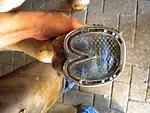Advertise Follow Us
Items Tagged with 'distal phalanx'
ARTICLES
What Were Farriers’ Online Footcare Interests in 2018?
Here’s a look at the “most viewed” content during the past year that appeared on the American Farriers Journal’s digital media platforms
Read More
Study Finds Hoof Changes As Horses Age
The palmar metric: A novel radiographic assessment of the equine distal phalanx
Read More
Shoeing for Distal Phalanx Fractures
Glue-on shoes are a good option when dealing with these situations
Read More
The Widest Part of the Foot
A study of locating internal hoof structures from external references
Read More
Hoof Care and the Coffin Bone
Understanding the form and function of the distal phalanx is vital to keeping horses sound
Read More
Vet's Corner
Acute and Chronic Laminitis: An Overview
Individualized approach based on adherence to principles produces best results
Read More
Clashing Views on Laminitis
A noted farrier questions the basis of an article in the May/June issue and the author responds
Read More
A Pain in the Back End
Four veterinarians discuss the all-too-common problem of palmar foot pain
Read More










